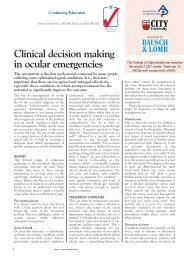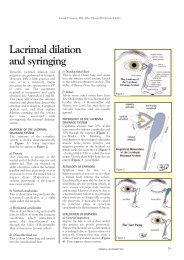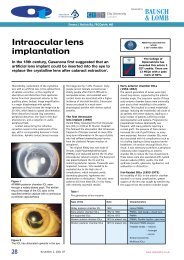Download the PDF
Download the PDF
Download the PDF
Create successful ePaper yourself
Turn your PDF publications into a flip-book with our unique Google optimized e-Paper software.
CET<br />
CONTINUING<br />
EDUCATION &<br />
TRAINING<br />
THIS ISSUE CET: FREE<br />
✔<br />
✔<br />
Approved for Optometrists Approved for DOs<br />
To gain more standard CET points for this year’s PAYL series, purchase your credits at<br />
www.otbookshop.co.uk and <strong>the</strong>n enter online at: www.otcet.co.uk to take your exams<br />
✘<br />
Sponsored by:<br />
breakdown of <strong>the</strong> corneal epi<strong>the</strong>lium.<br />
DM is a recognised risk factor for RCE<br />
and typical symptoms include pain,<br />
photophobia, blurred vision and<br />
hyperaemia.<br />
A decrease in corneal sensitivity has<br />
been demonstrated in individuals with<br />
79, 80<br />
DM and <strong>the</strong>refore, neurotrophic<br />
keratopathy must be considered when a<br />
patient with diabetes develops<br />
o<strong>the</strong>rwise unexplained corneal<br />
epi<strong>the</strong>lial disease. Equally, DM must be<br />
considered when a patient presents<br />
with an unexplained neurotrophic<br />
corneal ulcer. 75-81 Diabetic peripheral<br />
neuropathy has also been found to be<br />
related to <strong>the</strong> presence of diabetic<br />
keratopathy. 82<br />
Contact lens wearers that suffer from<br />
DM should be advised to take extra care<br />
with contact lens hygiene and should<br />
be advised to seek a medical opinion<br />
early if any symptoms of infection<br />
develop. Early intervention helps to<br />
prevent vision loss from microbial<br />
keratitis, <strong>the</strong> treatment of which is<br />
intensive topical antibiotic <strong>the</strong>rapy<br />
(usually hourly administration for <strong>the</strong><br />
first 48 hours).<br />
Slower healing of <strong>the</strong> cornea after<br />
LASIK surgery has been cited as a<br />
possible reason for <strong>the</strong> increased rate of<br />
complications seen in patients with<br />
diabetes undergoing this refractive<br />
procedure.<br />
Uveitis<br />
Associations between anterior uveitis<br />
(Figures 3 and 4) and DM have been<br />
reported. 83-85 Some but not all studies<br />
found that patients who suffered from<br />
diabetic autonomic neuropathy<br />
< Figure 4<br />
Posterior synechiae in uveitis<br />
appeared to have a higher rate of<br />
uveitis, suggesting a possible common<br />
autoimmune process. 86-88<br />
Ocular Ischaemic<br />
Syndrome<br />
The patient with ocular ischaemic<br />
syndrome (OIS) is typically an elderly<br />
male. OIS results from chronic vascular<br />
insufficiency and common findings<br />
include cataract, anterior segment<br />
inflammation, dilated retinal veins (but<br />
not tortuous), midperipheral large<br />
retinal haemorrhages, cotton-wool<br />
spots, and neovascularisation (iris,<br />
optic nerve, retinal). Ocular hypotony<br />
may even occur due to low arterial<br />
perfusion of <strong>the</strong> ciliary body.<br />
OIS should be suspected in elderly<br />
patients with a history of<br />
neovascularisation of <strong>the</strong> anterior<br />
segment. Symptoms include ocular<br />
pain and visual loss including<br />
89, 90<br />
amaurosis fugax. DM is a major risk<br />
factor for carotid artery stenosis and<br />
plaque formation. 91 Stenosis of <strong>the</strong><br />
carotid artery reduces perfusion<br />
pressure to <strong>the</strong> eye, resulting in <strong>the</strong><br />
ischaemic phenomena. The prevalence<br />
of diabetes in patients with OIS is<br />
<strong>the</strong>refore significantly higher than in<br />
<strong>the</strong> general population. 90 Carotid<br />
doppler ultrasonography is useful to<br />
delineate <strong>the</strong> presence and severity of<br />
carotid artery stenosis and carotid<br />
endarterectomy has been shown to<br />
slow or prevent <strong>the</strong> progress of chronic<br />
ocular ischaemia caused by internal<br />
carotid artery stenosis. 92 OIS has a<br />
poor visual prognosis and is also<br />
associated with a high mortality rate<br />
(five year mortality of 40%). The<br />
leading cause of death is cardiac<br />
disease, followed by stroke and<br />
93, 94<br />
cancer.<br />
Retinal Vascular Occlusion<br />
The central retinal artery originates<br />
from <strong>the</strong> ophthalmic artery and its<br />
artery branches feed <strong>the</strong> inner retinal<br />
layers. Central retinal artery occlusion<br />
(CRAO) deprives <strong>the</strong> entire inner retina<br />
of its blood supply unless a cilioretinal<br />
artery is present (15–30% of eyes).<br />
Patients with CRAO usually present<br />
with a sudden significant loss of vision,<br />
an afferent pupillary defect, diffuse<br />
retinal whitening, and <strong>the</strong> resultant<br />
classic ‘cherry spot’ on <strong>the</strong> macula.<br />
CRAO is associated with a poor final<br />
acuity of counting fingers or worse in<br />
approximately two-thirds of cases. 95<br />
Patients with branch retinal artery<br />
occlusion (BRAO), usually have a focal<br />
wedge-shaped area of retinal<br />
whitening. Visible emboli in retinal<br />
arteries are observed more frequently in<br />
patients with BRAO. 96 DM is a<br />
recognised risk factor for retinal artery<br />
occlusion and patients should be<br />
referred immediately to an<br />
ophthalmologist for management, in<br />
particular to rule out <strong>the</strong> possibility of<br />
Giant Cell Arteritis.<br />
Retinal vein occlusion (RVO) is an<br />
acute vascular condition characterised<br />
by dilated tortuous retinal veins with<br />
retinal haemorrhages, cotton wool<br />
spots, and macular oedema. Central<br />
RVO (CRVO) occurs at <strong>the</strong> optic disc,<br />
whereas branch RVO (BRVO) occurs at<br />
retinal branches, usually at <strong>the</strong> site of<br />
arterio-venous crossings (Figure 5).<br />
CRVO may be subdivided fur<strong>the</strong>r into<br />
non-ischaemic and ischaemic types,<br />
<strong>the</strong> latter is associated with a poorer<br />
visual prognosis. Many but not all<br />
studies have found an association with<br />
DM. 97-99 When a patient with DM<br />
presents with acute vision loss and<br />
asymmetric signs of retinopathy, RVO<br />
should be considered.<br />
Neuro-ophthalmic<br />
complications<br />
A range of neuro-ophthalmic<br />
manifestations occur secondary to<br />
diabetic eye disease and although<br />
relatively rare, some may be severely<br />
visually disabling and are <strong>the</strong>refore<br />
important to understand. Defects may<br />
be related to <strong>the</strong> vascular, neuropathic,<br />
or metabolic changes induced by DM.<br />
DM can affect <strong>the</strong> afferent visual<br />
system, <strong>the</strong> pupillary and<br />
accommodative reflexes, and <strong>the</strong><br />
efferent system. 100<br />
Facial Nerve Palsy<br />
Diabetic peripheral neuropathy, a<br />
microvascular disease, is characterised<br />
by loss of myelinated nerve fibres,<br />
degeneration, and blunted nerve fibre<br />
reproduction. 101<br />
Peripheral facial nerve palsies are<br />
relatively common and most frequently<br />
29<br />
08/05/09 CET
















